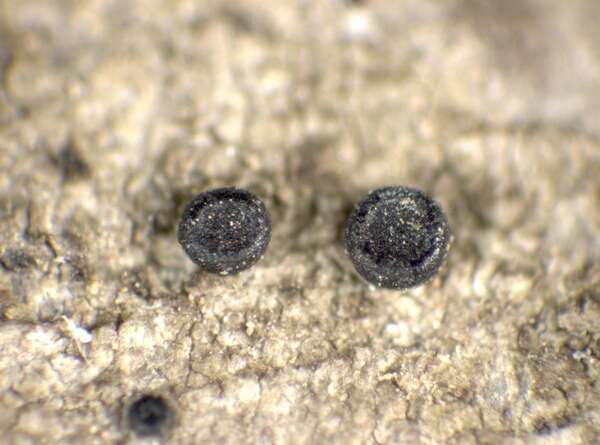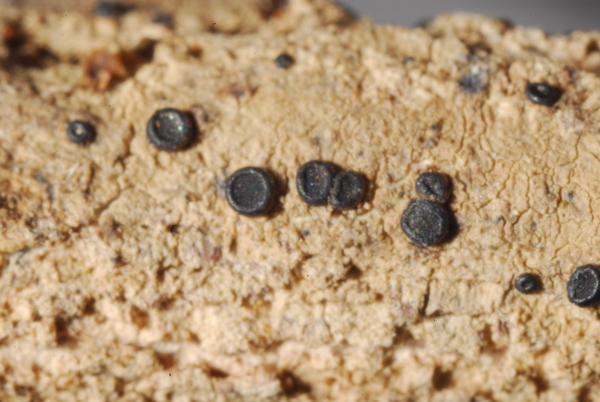Bacidia absistens (Nyl.) Arnold
Flora, 53: 472, 1870. Basionym: Lecidea absistens Nyl. - Flora, 52: 295, 1869.
Synonyms: Bacidia intermissa (Nyl.) Malme; Lecidea intermissa Nyl.
Distribution: N - TAA (Nascimbene & al. 2010, 2022). C - Tosc (Ravera & al. 2021c), Laz (Ravera 2006, 2006c). S - Camp (Nimis & Tretiach 2004, Garofalo & al. 2010, Ravera & al. 2021c), Bas (Potenza & al. 2014), Cal (Puntillo 1995, 1996), Si (Nimis & al. 1994, Ravera & al. 2024).
Description: Thallus crustose, thinly episubstratic, white to grey, continuous, smooth or granular-warted. Apothecia lecideine, 0.3-0.6(-1) mm across, black to grey in shade-forms, with a flat to rarely convex disc, and a thin, usually persistent proper margin. Proper exciple dark green and K+ intensifying green in outer part, pale red-brown and K- or K+ purple within, with abundant small crystals dissolving in K, visible under polarized light; epithecium blue-violet or purple-brown, rarely green, K+ green N+ purple-violet (with the precipitation of small blue crystals); hymenium colourless, 60-95 μm high; paraphyses simple or forked, 1-1.5 μm thick at mid-level, the apical cells up to 4 μm wide; hypothecium colourless or pale yellowish brown in lower part. Asci 8-spored, clavate to cylindrical-clavate, the apical dome K/I+ dark blue with a pale, conical-pointed apical cushion (axial mass), the wall I-, but the thin outer gel I+ blue, Bacidia-type. Ascospores 7-16-septate, hyaline, needle-like, 45-80 x 2-3(-4) μm. Pycnidia very small, immersed. Conidia thread-like, curved, 7-32 x c. 0.5 μm. Photobiont chlorococcoid, the cells 5-12(-14) μm in diam. Spot tests: thallus K, C-, KC-, P-, UV-. Chemistry: unidentified orcinol meta-depsides. Note: a mild-temperate to humid subtropical species found on acid bark in clearings of ancient forests, sometimes on epiphytic bryophytes; mainly Tyrrhenian, but to be looked for also in humid parts of the Alps. It is included in the Italian red list of epiphytic lichens as “Vulnerable” (Nascimbene & al. 2013c).
Growth form: Crustose
Substrata: bark
Photobiont: green algae other than Trentepohlia
Reproductive strategy: mainly sexual
Most common in areas with a humid-warm climate (e.g. most of Tyrrenian Italy)
Commonnes-rarity: (info)
Alpine belt: absent
Subalpine belt: absent
Oromediterranean belt: absent
Montane belt: absent
Submediterranean belt: extremely rare
Padanian area: absent
Humid submediterranean belt: extremely rare
Humid mediterranean belt: very rare
Dry mediterranean belt: absent

Predictive model
Herbarium samples
Growth form: Crustose
Substrata: bark
Photobiont: green algae other than Trentepohlia
Reproductive strategy: mainly sexual
Most common in areas with a humid-warm climate (e.g. most of Tyrrenian Italy)
Commonnes-rarity: (info)
Alpine belt: absent
Subalpine belt: absent
Oromediterranean belt: absent
Montane belt: absent
Submediterranean belt: extremely rare
Padanian area: absent
Humid submediterranean belt: extremely rare
Humid mediterranean belt: very rare
Dry mediterranean belt: absent

Predictive model
| Herbarium samples |
 INDEX FUNGORUM
INDEX FUNGORUM
 GBIF
GBIF
 DOLICHENS
DOLICHENS




